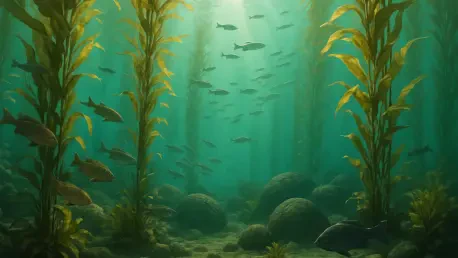Off the northern coast of Portugal, hidden beneath the waves, lies an underwater world of towering kelp forests that play a monumental role in combating climate change, yet face an uncertain future due to environmental pressures. These marine ecosystems, dominated by species like Laminaria hyperborea and Saccorhiza polyschides, are not just havens of biodiversity but also powerful carbon sinks, capturing and storing vast amounts of carbon dioxide. Recent research from Portugal’s leading marine science institutions has shed light on their significance, revealing that these forests store an impressive amount of carbon across thousands of hectares. However, rising sea temperatures and shifting ecological dynamics threaten to unravel their critical contributions. As global attention turns to blue carbon strategies for climate mitigation, the plight of these underwater giants demands urgent recognition and action to preserve their ecological and economic value.
Unseen Heroes of Carbon Storage
The significance of Portugal’s kelp forests as carbon reservoirs cannot be overstated, especially given their relatively small geographical footprint. Spanning approximately 5,189 hectares along the northern coastline, these underwater habitats store around 16.48 gigagrams of carbon, an amount comparable to the storage capacity of much larger ecosystems like salt marshes or seagrass beds. This remarkable efficiency positions them as key players in the concept of blue carbon, which refers to carbon captured by marine and coastal ecosystems. Accounting for 14 percent of the country’s documented blue carbon inventory, these forests also sequester a third of the carbon absorbed annually by Portugal’s marine plant habitats. Such figures highlight their disproportionate impact on climate mitigation, a role that has often been overshadowed by more widely studied terrestrial systems. The research behind these findings marks the first quantitative assessment of carbon reserves in these specific marine environments, offering a vital benchmark for future conservation efforts.
Beyond their raw numbers, the carbon sequestration capabilities of kelp forests reveal a broader environmental benefit that extends to global climate strategies. Unlike many other ecosystems, kelp grows rapidly, allowing it to absorb carbon dioxide at an accelerated pace, which is then locked away in the ocean floor as biomass decomposes or is buried. This process not only helps reduce atmospheric greenhouse gases but also supports the stability of marine ecosystems by providing a foundation for diverse aquatic life. The northern Portuguese coast, representing the southernmost range for some kelp species, offers unique conditions that amplify the resilience and productivity of these forests. However, this delicate balance is at risk as environmental changes challenge their ability to thrive. Understanding the full scope of their carbon storage potential is a critical step toward integrating these habitats into national and international climate policies, ensuring their contributions are not overlooked in the broader fight against global warming.
Climate Challenges and Ecological Shifts
The looming threat of climate change casts a dark shadow over the future of Portugal’s kelp forests, with rising sea temperatures driving significant ecological disruptions. A phenomenon known as tropicalization is altering marine environments, as warmer waters allow tropical and subtropical species to encroach into northern regions traditionally dominated by kelp. This shift disrupts the delicate balance of local biodiversity, weakening the structural integrity of kelp forests and diminishing their capacity to store carbon effectively. Such changes also impact the myriad species that rely on these habitats for shelter and sustenance, creating ripple effects across the marine food web. The vulnerability of these ecosystems is compounded by their historical underrepresentation in conservation priorities, leaving them exposed to degradation without adequate protective measures in place to mitigate these emerging threats.
Compounding these challenges is the broader impact of climate-driven stressors on the ecological services provided by kelp forests. Beyond carbon sequestration, these underwater environments play a pivotal role in maintaining water quality, preventing coastal erosion, and supporting fisheries that are vital to local economies. As temperatures continue to rise, the risk of widespread kelp die-offs increases, potentially releasing stored carbon back into the atmosphere and exacerbating climate issues. Researchers have emphasized that the southern frontier of these species’ range, as seen along Portugal’s coast, is particularly susceptible to such shifts, making it a critical area for monitoring and intervention. The urgency to address these changes is clear, as the loss of these habitats would not only undermine climate mitigation efforts but also jeopardize the livelihoods and ecosystems dependent on their health. Proactive steps are needed to adapt to these evolving conditions and safeguard the long-term viability of these marine treasures.
Pathways to Protection and Restoration
In response to the mounting threats facing Portugal’s kelp forests, a concerted push for protective policies and restoration initiatives has emerged as a critical priority. Experts advocate for the integration of these marine habitats into national and international blue carbon frameworks, recognizing their dual role as carbon sinks and biodiversity hotspots. With the European Union’s Nature Restoration Law gaining traction, there is a timely opportunity to develop targeted strategies that prioritize the monitoring and preservation of vulnerable ecosystems like kelp forests. Such policies could include establishing protected marine areas, enforcing sustainable fishing practices, and investing in research to better understand the dynamics of carbon storage in these environments. The call for action underscores the need to elevate the visibility of these underwater ecosystems in broader environmental discussions.
Looking back, the efforts to protect these vital habitats were rooted in a growing awareness of their outsized environmental contributions. Restoration techniques, once in their infancy, were tested and refined to rebuild degraded kelp forests, ensuring they could continue to sequester carbon and support marine life. Partnerships between scientists, policymakers, and local communities proved instrumental in driving these initiatives forward, laying the groundwork for sustainable management practices. Reflecting on those endeavors, it became evident that safeguarding these ecosystems required a blend of innovation and commitment. Moving ahead, the focus must shift to scaling up successful models, securing funding for long-term conservation projects, and fostering global collaboration to address the shared challenges of climate change. Only through such dedicated efforts can the legacy of Portugal’s kelp forests as unsung heroes of climate mitigation be preserved for future generations.









